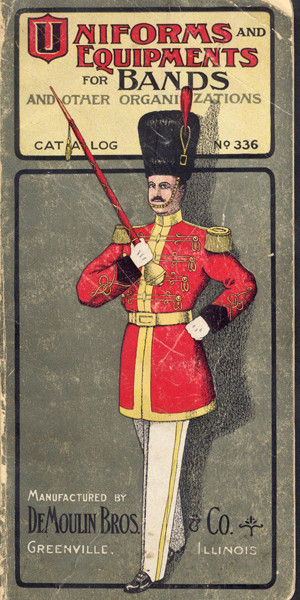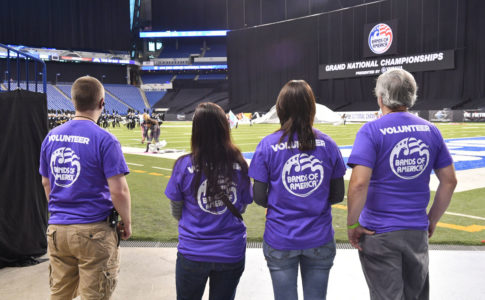Dating way back to the ancient Greco-Roman civilizations, marching band uniforms have strong military ties based on practical needs. From shakos to spats and everything in between, how have designs evolved or kept to their roots through all these years?
Photo courtesy of DeMoulin Bros.
While the 2010 World Cup played on TV, Brent Becker—a Stanbury marching band uniform designer—watched and became inspired by the American goalie’s jersey. Becker quickly grabbed a pen and started sketching band uniforms. He watched the rest of the match while drawing.
Becker gets design ideas while watching TV, attending car shows and going about his daily life. When inspiration hits, he’ll sometimes leave a verbal reminder on his cell phone. Pen sketches come next, followed by drawings with colored markers. He’ll usually create 15 to 20 sketches per client.
While modern objects influence band uniform designers, uniforms still reflect ancient, military roots. Some elements date back to Greco-Roman times! As the marching arts have developed and technology has evolved, uniforms have too, yet they remain linked to their past.
“Marching band uniforms won’t escape their military past outright,” Becker says. “It’s important to understand where uniforms have been in order to get a sense of where it’s possible to take them.”
Military Roots
Uniforms began as a practical way for militias to wear armor and protect themselves. They emphasized safety instead of uniformity. Yet, to show loyalty to the land they were protecting, the men would wear a sprig from a local plant or feather from a local bird in their hats. This tradition served as the basis for the modern plume.
Not only does the plume date back to the Middle Ages, but so does the tradition of distinct drum major uniforms. Enlisted men would wear issued overcoats, sometimes accessorized to show their units. But officers purchased their own outfits. Today, drum majors’ uniforms often stand out from the rest of the band. Popular white uniforms or black uniforms with white gloves help the conductor pop against a crowd.
In the 17th and 18th centuries, military uniforms drew upon French design and ornamentation. Uniforms adopted elaborate trim, hats and buttons.
Technology also allowed fabrics to be dyed more colors. “The color wasn’t so much about aesthetics as it was being able to tell one team from another, much like what we have in our sports teams today,” Becker says. “With all the artillery fire, smoke and dust, the colored uniforms were practical.
Military musicians were issued brightly colored uniforms; during the Civil War, they wore baby blue and purple uniforms. It was too expensive to outfit the entire military in these colored uniforms, so they were reserved for the band. And the color difference helped the enemy recognize musicians, so they wouldn’t shoot them, Becker says.
In the 19th century, the West Point Cadet style uniform with bars across the chest became popular military outfits. The West Point Cadet style uniform has remained popular for some marching groups such as The Cadets Drum and Bugle Corps, Boston Crusaders Drum and Bugle Corps and L.D. Bell High School.
Bands pattern their uniforms after military uniforms because that is where the marching arts developed. Drummers kept the cadence for military units in battle, and buglers were added later. The military bands grew into parade bands, marching bands, and drum and bugle corps. Interestingly, many collegiate marching bands were bundled into the school’s ROTC program.
At Michigan State University, the Spartan Marching Band began in 1870 with only 10 members; all were Civil War veterans. Even in the 1940s, the group remained a part of the ROTC. The marching band got its first non-military uniform in 1952.
The new uniforms were green and white with a decorative white cross-strap and white hat with a green and white plume.
Contemporary Construction, Design
David LeBlanc, a representative for De- Moulin Bros. and Co., says that uniform construction has improved greatly since the 1960s. “Uniforms today are far more comfortable,” he says.
Band uniforms have gone from 100 percent wool to polyester blends and washable fabrics. Fred J. Miller (FJM) Inc. strictly offers washable uniforms. And Stanbury Uniforms is experimenting with a new athletic-like fabric called XtremeDri, which helps wick sweat off the body.
Overall, outfits have become more athletic, streamlined and abstract. Becker thinks the loss of confidence in the military during the Vietnam War sparked the change in marching band uniforms.
Michael J. Cesario, uniform designer for FJM, believes there are other reasons for less militaristic band uniforms. Military ornamentation, such as citation cords, can be hard to see from a distance. Instead of thinking about a uniform as a singular item you see in a mirror, you must think of the uniform in terms of multiples seen at a distance, he says. “I’m the one taking the military stuff off the uniform,” Cesario says.
Uniforms have also needed to adapt with changing marching styles. Curvilinear marching is now more popular than block styles. Stripes down uniform legs don’t appeal as much in curved forms as they do in straight forms, Cesario says. Likewise, spats—which add to visual effect but also have military roots and practical uses to protect the shoes and ankles—are now thought to bring attention to differences in shoe size instead of uniformity, which explains why some groups have stopped using them, he adds.
Forward-looking uniforms are using color gradation effects. This means a uniform could be black at the feet and fade to a white jacket. Lately, there has also been a trend toward using reflective material such as plastics, sequins and mirrors. Jacket cutouts, where color peeks through windows, are gaining popularity. These windows allow schools to switch the underlying colors yearly to match their show’s theme.
Groups are also replacing long coats with short jackets to change the students’ silhouette. Richard Fruhauf, executive vice president at Fruhauf Uniforms, says that ensembles are choosing short-waisted jackets to create an illusion of height. Fruhauf Uniforms, which is celebrating its 100th year of making band uniforms, has experienced and led design changes firsthand.
In addition, some groups are muting the band in darker colors, so the audience looks at the color guard’s work, Becker says. For some bands, this change shows a shift to more theatrical performances. Not to mention, the dark uniforms help hide dirt.
According to Cesario, uniform design must meet three criteria: “visibility, identity and practicality.”
Group Identity
While contemporary design has become more acceptable, members at Fruhauf, FJM, Stanbury and DeMoulin agree that the uniform must fit the ensemble. “Marching band is a show of sight and sound, and uniforms give you identity,” Fruhauf says.
The uniform provider must understand the group’s mentality and the kind of performances they strive to create. In some parts of the country—especially the South—traditional uniforms reign supreme. Other parts of the country— like the East—boast more contemporary uniforms.
Not only are there regional differences, but drum corps tend to be more progressive than high school and college bands, Fruhauf explains. But some corps do choose to maintain a traditional look to preserve their identity.
The Madison Scouts Drum and Bugle Corps performed in new uniforms this season. Although the group had new uniforms in 2008, it wanted a different look to match its new vision and to pay homage to its history.
The 2008 uniform had a dark green jacket with a red tie, small gauntlets and the corps’ traditional white Aussie hat.
But beginning in January, Jim Mason— legendary director of Star of Indiana, founder of “BLAST!” and now artistic director of the Madison Scouts—worked with Brent Becker to refocus the ensemble’s look.
The latest uniform now nods to the Madison Scouts’ 1970’s and 80’s uniform and to the corps’ history with the Boy Scouts of America, says Chris Komnick, executive director. (The group once wore actual explorer Boy Scout uniforms, which were dark forest green with neckerchiefs!)
Over the years, the group experimented with military-style uniforms; however, it kept returning to elements of the Boy Scouts uniform. Thus, the 2010 uniform is forest green with white citation cords, a white tie, white gauntlets, and a black and silver sash. The white Aussie hat has black and silver trim that—like the sash—can be changed for different colors year-to-year. “The essence of being a Madison Scout is captured in the uniforms,” Komnick says.
Wearing the uniform draws pride from the Madison Scouts. As members came in for final uniform fittings, Komnick noticed that the kids stood taller and puffed out their chests. At the Madison Scouts, the uniform is talked about as being a Superman suit, Komnick says. The Scouts must carry themselves professionally in their outfits. “You don’t step on Superman’s cape,” he says.
Marching band uniforms are a source of pride for students nationwide. Fruhauf, who has joined his son’s high school uniform committee, sees firsthand how students light up while wearing his company’s uniforms. “Everyone needs to feel good about themselves,” he says.
While uniforms today employ modern construction techniques, the military-inspired costuming evokes the same sense of importance and grandeur as during ancient times.
About the Author
Sabrina Lochner is an editorial intern for Halftime Magazine. She recently graduated from Syracuse University with bachelor’s degrees in magazine journalism and political science and a minor in architecture. She served as drum major of the Syracuse University Marching Band for three years and has played the clarinet since fifth grade. She will be attending law school in the fall.


